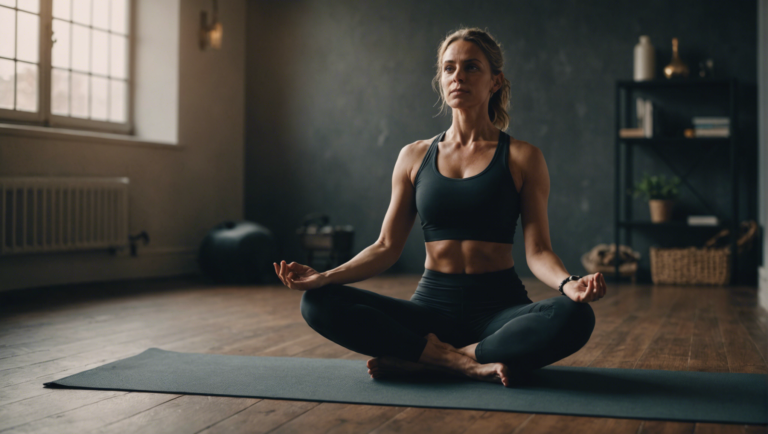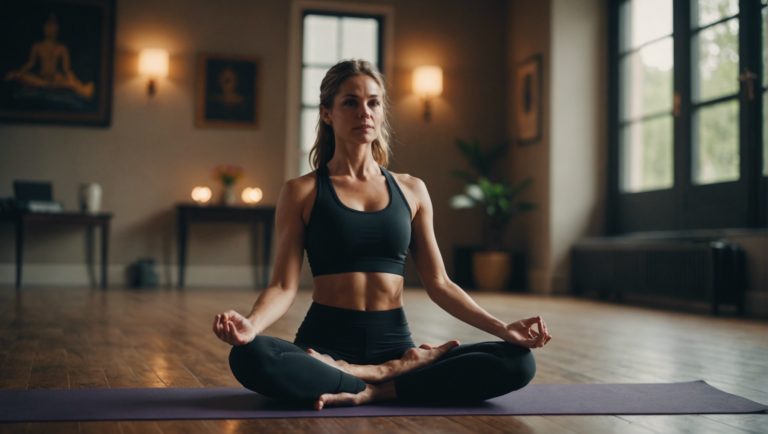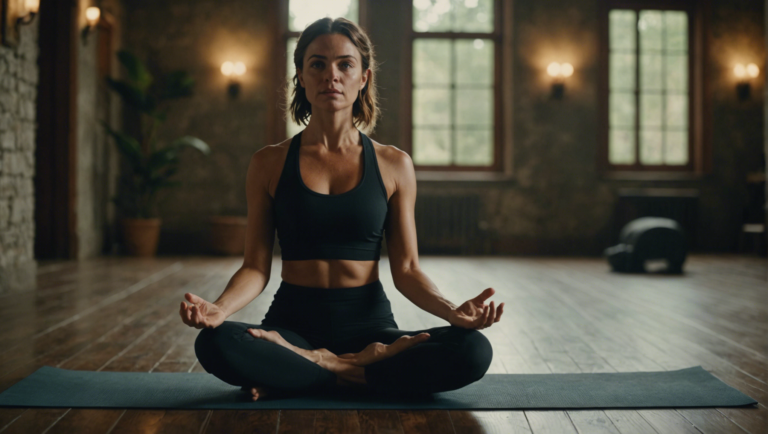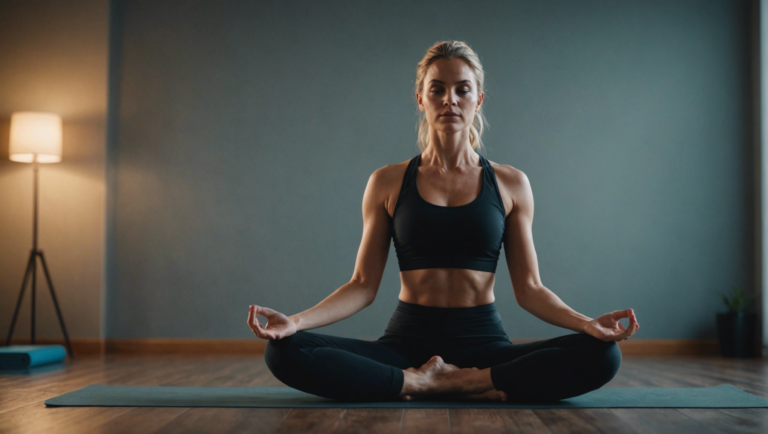Can Practicing Yoga Regularly Make You Sore?
Can Practicing Yoga Regularly Make You Sore? Understanding the Body’s Response
Embarking on a yoga journey can be a transformative experience, blending physical postures, breathing techniques, and meditation into a holistic practice. For many, yoga has become an essential component of their fitness and wellness routine, offering benefits such as increased flexibility, reduced stress, and improved mental clarity. However, as with any physical activity, the question arises: does regular engagement in this ancient practice lead to muscle soreness, and if so, why? Understanding how our bodies respond to yoga can shed light on this experience, helping practitioners navigate their practice with awareness and care.
The Physiology Behind Muscle Soreness
Before diving into the specifics of yoga-induced soreness, it’s important to understand the general mechanics behind muscle soreness. When we engage in any form of physical exercise that puts more strain on our muscles than usual, it can lead to microscopic tears in the muscle fibers, a phenomenon scientifically known as muscle hypertrophy. This process is natural and is part of how our muscles grow and become stronger. The soreness felt after a workout, often referred to as Delayed Onset Muscle Soreness (DOMS), results from this muscle fiber damage and the body’s subsequent inflammatory response.
Yoga’s Unique Physical Demands
Yoga, with its myriad of poses ranging from gentle stretches to gravity-defying holds, places unique demands on the body. Unlike high-intensity workouts that primarily cause soreness due to rapid, repetitive movements, yoga’s blend of static holds, deep stretches, and strength-building poses can also lead to soreness, albeit through different mechanisms.
-
Static Holds and Muscle Fatigue: Many yoga poses require holding a position for an extended period. This static engagement challenges the muscles, leading to fatigue and, potentially, soreness as the muscles repair and strengthen in response.
-
Deep Stretching and Flexibility: Yoga significantly emphasizes flexibility and deep stretching. For individuals new to yoga or those practicing more intensive stretches, this can cause soreness as the muscles are elongated beyond their typical capacity, causing microtears similar to other forms of exercise.
-
Strength-Building Poses: Poses that require lifting and supporting one’s body weight, such as arm balances and inversions, aggressively work the muscle groups, leading to the kind of tear and repair cycle synonymous with muscle growth and soreness.
Navigating Yoga-Induced Soreness
Understanding that soreness can be a part of the yoga experience, especially for beginners or those deepening their practice, is critical. Here are strategies to manage and mitigate soreness, ensuring a healthy and sustainable practice:
-
Listening to Your Body: The foundational practice of yoga is awareness—of breath, of body, and of mind. Tuning into your body’s signals and differentiating between good pain (mild discomfort and stretching) and bad pain (sharp, injurious pain) is vital. Adjusting your practice according to what your body needs each day is a skill developed over time.
-
Gradual Progression: As with any physical activity, gradually increasing the intensity and duration of your yoga practice can help minimize soreness. Give your body time to adapt to new poses and challenges.
-
Adequate Rest and Recovery: rest days into your yoga routine allows your muscles to recover and rebuild. Engaging in gentle, restorative practices can also aid in muscle recovery while still maintaining your practice.
-
Hydration and Nutrition: Proper hydration and a balanced diet rich in anti-inflammatory foods can support muscle repair and reduce soreness. Staying hydrated and nourished ensures your body has the necessary components for recovery.
Embracing the Journey with Mindful Awareness
The journey through yoga is as much about the body as it is about the mind. Experiencing soreness can be a part of this journey, reflecting the physical and mental growth that comes with a dedicated practice. By understanding the physiological responses of our bodies to yoga, we can navigate our practice with greater awareness and care, embracing the discomfort as a sign of growth and transformation. Through mindful practice, adequate self-care, and a compassionate approach to our bodies’ limits, we can enjoy the vast benefits of yoga, including enhanced strength, flexibility, and overall well-being, while minimizing discomfort and fostering a sustainable, fulfilling practice.
Unveiling the Myths: Does Yoga Only Bring Peace and No Pain?
Understanding the Physical Demands of Yoga
Yoga, with its ancient origins and spiritual roots, often conjures images of serene settings, peaceful meditations, and gentle stretching. However, beneath its tranquil surface lies a physical discipline that can challenge the body in unexpected ways. While yoga promotes health, flexibility, and mental wellbeing, it is not without its physical demands, which may sometimes lead to soreness, especially for beginners or those exploring new forms of this practice.
The Reality of Muscle Engagement in Yoga
One common misconception is that yoga is solely about stretching and balance. While these elements are crucial, yoga also involves significant muscle engagement. Poses like Chaturanga, Warrior sequences, and even the seemingly simple Plank, require a level of strength and endurance. For individuals new to these movements, or even seasoned practitioners pushing their limits, this can lead to muscle fatigue and soreness, similar to what one might experience after a strenuous workout session.
Listen to Your Body: The Key to Balancing Effort and Ease
Yoga teaches the principle of Sthira and Sukha—effort and ease. This balance is crucial in preventing soreness and injury. It’s the difference between pushing your body to its safe limit and going beyond it into the territory of potential harm. Learning to listen to your body, understanding your current limitations, and gradually expanding those boundaries through consistent practice is essential.
Adaptation and Overcoming Soreness
The body is remarkably adaptable. Regular yoga practice often leads to an increase in strength and flexibility, which in turn will reduce instances of soreness over time. However, this is not an overnight process. It requires consistency, patience, and understanding that progress in yoga is incremental. Utilizing yoga accessories like blocks, straps, and cushions can also aid in performing poses correctly, minimizing the risk of pain.
The Importance of Proper Technique and Instruction
Much like any physical exercise, the correct technique in yoga is paramount. Poor alignment and improper form can lead not only to soreness but to injury as well. This underscores the importance of practicing with a knowledgeable instructor who can provide guidance, modifications, and adjustments tailored to each individual’s needs and capabilities. In the era of digital learning, online resources and virtual classes have made access to expert instruction more readily available than ever.
Yoga’s Holistic Approach to Wellbeing: Beyond Physical Soreness
Yoga is more than just physical practice; it’s a holistic approach that encompasses mental and emotional wellbeing. The soreness experienced in the early stages of practice can be likened to growing pains. It’s a signal from the body that it is being challenged and is adapting. Over time, many practitioners find that yoga offers a newfound strength, not just physically but also mentally and emotionally, helping to navigate life’s stresses with greater resilience and peace.
Embracing the Journey: From Soreness to Strength
The path of yoga is unique for each individual. Soreness may be a part of this journey, but it is by no means the focal point. Instead, it serves as a reminder of growth, a step towards greater physical strength, and a deepening of mental focus. With time, the practice evolves, and what once caused discomfort becomes a source of strength and vitality.
Yoga’s blend of physical discipline, mental focus, and spiritual insight offers a comprehensive approach to health that transcends the mere absence of pain. As such, the initial soreness experienced by many at the start of their yoga journey is but a transient phase, paving the way to greater fulfillment and wellbeing.
The Significance of Consistency in Yoga: Balancing Effort and Ease
The Vital Role of Regular Practice in Yoga
Regular yoga practice stands as the cornerstone of not only advancing in the physical aspects of yoga but also in deepening the mental and spiritual connections it fosters. The ancient discipline of yoga, steeped in thousands of years of tradition, implores its practitioners to find a harmonious balance between effort and ease—a concept deeply rooted in the philosophy of yoga.
Understanding the Principle of Sthira and Sukha
At the heart of yoga, there exists a guiding principle known as Sthira (steadiness) and Sukha (ease). This principle emphasizes the importance of integrating a balance of effort and relaxation into practice. The aim is not only to achieve physical postures but to cultivate an inner sense of peace and stability. When practiced consistently, yoga challenges the body and mind, fostering growth and resilience while simultaneously encouraging an attitude of calmness and acceptance.
Transforming Challenges into Opportunities for Growth
For many beginners, the initial foray into yoga can be met with physical soreness and mental frustration. This is a natural part of the learning process, where the body and mind are being asked to adapt to new demands. Regular practice plays a crucial role in transforming these challenges into opportunities for growth. It allows the body to gradually build strength and flexibility, reducing soreness over time, and it trains the mind to remain focused and serene in the face of difficulty.
The Science Behind Consistency in Yoga Practice
The benefits of consistent yoga practice are supported by a growing body of scientific research. Studies have shown that regular yoga practice can significantly impact physical health by improving cardiovascular fitness, flexibility, and balance. It also has profound effects on mental health, contributing to reductions in stress, anxiety, and depression. The key to unlocking these benefits lies in the commitment to regular practice, allowing the effects of yoga to compound over time.
Tailoring Your Practice to Suit Your Needs
A common misconception is that a rigorous daily practice is required to achieve the benefits of yoga. However, consistency doesn’t necessarily mean practicing intensely every day. It’s about finding a routine that suits your individual needs and sticking to it. For some, this might mean practicing for a short period daily; for others, a longer session a few times a week may be more beneficial. The critical factor is regular engagement with the practice, allowing yoga to become a sustaining part of your life.
Navigating the Path of Progress: Effort and Ease
As individuals delve deeper into their yoga journey, the interplay between effort and ease becomes increasingly significant. Balancing these two forces is crucial for preventing burnout and injury. By listening to the body and respecting its limits, practitioners can challenge themselves safely, making gradual progress. Simultaneously, cultivating a sense of ease and acceptance during practice can enhance mental well-being and spiritual growth.
Cultivating a Mindful Approach to Practice
Mindfulness is a practice that complements the physical aspects of yoga, enriching the experience and enhancing its benefits. By being fully present during practice, individuals can more effectively balance effort with ease. This mindful approach helps in recognizing the signs of undue strain and in appreciating the moments of tranquility. The practice of mindfulness within yoga encourages a deeper connection with the self and with the present moment, leading to a more fulfilling practice.
Embracing the Journey
Yoga is not just about achieving perfect postures or mastering complex sequences; it’s about the journey. Each practice is an opportunity to explore the balance between pushing your limits and nurturing your well-being. Consistency in practice lays the foundation for this exploration, guiding individuals toward greater strength, flexibility, and peace of mind. As practitioners commit to regular practice, they unlock the true essence of yoga—transforming their practice from a routine into a pathway to personal growth and self-discovery.
Yoga’s Healing Soreness: When Discomfort Translates to Growth
Yoga, a millennia-old practice rooted in fostering the connection between body, mind, and spirit, has surged in global popularity as a holistic approach to wellness. Its adaptability and varied styles—from the slow, meditative stretching of Hatha yoga to the rigorous, heat-building sequences of Vinyasa—enable practitioners of all levels to find a method that resonates with their physical condition and spiritual quest. However, as with any physical activity, the journey through yoga is often accompanied by its fair share of physical discomfort, particularly for newcomers or those engaging in more intense sessions. This phenomenon raises a pertinent inquiry: Can practicing yoga regularly lead to muscle soreness, and if so, does this discomfort signify a beneficial transformation?
The Nature of Soreness in Yoga
Muscle soreness after yoga, especially for beginners or those trying new poses, can indeed be a common experience. This soreness is predominantly due to micro-tears that occur in the muscle fibers as they are stretched and stressed in new ways. Although the term ‘tears’ may sound alarming, this is a normal process in any form of exercise, signaling the muscles are being strengthened and conditioned. In yoga, this often results from engaging muscles that aren’t frequently used in daily life or are being stretched beyond their usual range of motion.
Understanding the Growth Behind the Discomfort
Engaging in regular yoga practice introduces the body to a variety of postures and movements that challenge it physically and mentally. This challenge is not merely about flexibility but also about strength, balance, and endurance. The soreness experienced, while a sign of the body’s adaptation process, also indicates its growth. As muscle fibers repair and strengthen, practitioners typically notice an improvement in their flexibility, strength, and how poses that once were challenging become more accessible.
The Role of Rest and Recovery
An essential element in transforming soreness into growth is the incorporation of adequate rest and recovery into your yoga routine. Listen to your body and allow it the time it needs to repair and strengthen. Engaging in gentle, restorative yoga practices or taking complete rest days are vital steps in preventing overuse injuries and promoting muscular recovery. Hydration, proper nutrition, and even practices like mindfulness can further enhance the body’s healing process, making your yoga journey more sustainable and enjoyable.
Signs to Pay Attention To
While mild to moderate muscle soreness is a healthy sign of growth, it’s critical to differentiate between this expected discomfort and potential signs of injury. Sharp, acute pain during or after practice, or soreness that doesn’t improve with rest and recovery efforts, should not be ignored. These could be indicators of strain or over-extension and may necessitate a consultation with a healthcare provider or a yoga therapist to adjust your practice accordingly.
Embracing the Journey
Yoga is as much a physical exercise as it is a spiritual exploration; discomfort and soreness are integral parts of the journey towards achieving greater harmony within the body and mind. This journey is uniquely personal, and what constitutes a transformative challenge for one may not be the same for another. It is thus crucial to approach your practice with self-awareness and gentleness, acknowledging your body’s current capabilities while gently pushing its boundaries.
Final Thoughts
Practicing yoga can indeed lead to muscle soreness, an undeniable testament to the body’s ongoing adaptation and development through the practice. This soreness, when approached with awareness, rest, and care, translates into growth — in strength, flexibility, and inner resilience. As we embrace these signs of our body’s evolving narrative, we learn not just to navigate, but to appreciate the intricate dance of discomfort and growth, recognizing its value in our journey towards holistic well-being and self-discovery.
Navigating Post-Yoga Soreness: Tips and Strategies for Recovery and Strengthening
Embarking on a yoga journey offers a spectrum of benefits for both the mind and body, encompassing increased flexibility, improved mental clarity, and enhanced overall wellbeing. However, as with any physical activity, embracing this ancient practice can sometimes lead to muscle soreness, especially for beginners or individuals exploring new poses and intensifying their routines. This soreness, commonly referred to as delayed onset muscle soreness (DOMS), can be a testament to your body’s adapting and strengthening process. Understanding how to manage and alleviate this discomfort is crucial for maintaining motivation and ensuring a sustainable yoga practice. Below are expert tips and strategies aimed at recovering from post-yoga soreness while continuing to strengthen your body.
Recognizing the Role of Adequate Hydration
Hydration Before and After Your Practice
Staying adequately hydrated is pivotal in preventing and alleviating muscle soreness. Water plays a crucial role in lubricating joints, transporting nutrients to cells, and facilitating the removal of waste products from the body. Ensuring you drink enough water before and after your yoga session can significantly reduce the intensity of soreness.
Embracing Proper Nutrition
Foods That Support Muscle Recovery
Nutrition significantly impacts muscle recovery and soreness reduction. foods rich in omega-3 fatty acids, such as salmon and chia seeds, can help reduce inflammation. Meanwhile, proteins provide the necessary amino acids for muscle repair and recovery. Including a balanced diet with a focus on anti-inflammatory foods and sufficient protein can aid in quicker recovery from post-yoga soreness.
Integrating Active Recovery
Gentle Movements on Rest Days
While it might seem counterintuitive, engaging in light physical activity, known as active recovery, can be beneficial in alleviating muscle soreness. Gentle yoga sequences, walking, or light stretching can enhance blood circulation to the muscles, which helps in reducing stiffness and promoting quicker healing.
Utilizing Cold and Heat Therapy
Alternating Between Cold and Heat for Optimal Recovery
Applying cold packs or ice to sore muscles immediately after your yoga session can help in reducing inflammation and numbing sore areas. After the initial 24-48 hours, switching to heat therapy through warm baths or heat packs can assist in relaxing and loosening stiff muscles, further aiding in recovery and comfort.
Prioritizing Rest and Sleep
The Importance of Adequate Sleep for Muscle Recovery
Never underestimate the power of rest and sleep in the muscle recovery process. During sleep, the body enters repair mode, healing damaged tissues, and replenishing energy stores. Ensuring you get enough quality sleep is vital for optimal recovery and readiness for your next yoga session.
Employing Mindfulness and Relaxation Techniques
Mind-Body Connection in Alleviating Soreness
Yoga is as much about the mind as it is about the body. Employing mindfulness and relaxation techniques, such as meditation and deep breathing exercises, can help in reducing the perception of pain associated with sore muscles. This mind-body approach is essential in managing discomfort and enhancing the overall yoga experience.
Consulting with Yoga Professionals
Seeking Guidance for Proper Form and Practice
One of the common causes of excessive soreness is incorrect posture or technique during yoga. Consulting with experienced yoga instructors can provide insights into proper form and adjustments specific to your body’s needs. This personalized guidance can not only help in reducing the risk of injury but also in minimizing post-yoga soreness.
Navigating post-yoga soreness involves a combination of proactive strategies and responsive techniques aimed at recovery and strengthening. By recognizing the importance of hydration, nutrition, active recovery, temperature therapy, rest, mindfulness, and professional guidance, practitioners can enhance their yoga journey, making it a more comfortable and fulfilling experience. Implementing these tips not only aids in faster recovery but also contributes to a deeper, more sustained practice that benefits both the mind and body.
Conclusion
Embarking on a yoga journey offers an enlightening path toward physical wellness, mental peace, and spiritual balance. However, as we delve into the layers of this ancient practice, it’s clear that the experience is not solely one of tranquility and effortless positioning; physical soreness can indeed be a companion along the way. This nuanced understanding challenges the oversimplified view that yoga is an entirely gentle or pain-free endeavor. Instead, it proposes a more realistic perspective that embraces the full spectrum of bodily responses to yoga, including the potential for discomfort and the intrinsic value of this experience.
The discussion about whether practicing yoga can make you sore uncovers the intricate dance between the body’s adaptive responses and the nature of yoga itself. It’s essential to acknowledge that discomfort and soreness are natural and expected outcomes, especially for beginners or those venturing into more strenuous forms of yoga. This physical sensation is a direct communication from the body, indicating areas of tension, the building of strength, or the stretching of previously underutilized muscles. Far from being a negative side effect, this soreness is a testament to the body’s ongoing process of adaptation and growth. It signifies not just the physical exertion that comes with practicing yoga but also the body’s endeavor to reach new levels of flexibility, strength, and endurance.
Dispelling myths around yoga is crucial for setting realistic expectations for practitioners. The notion that yoga is solely a peaceful journey, devoid of any discomfort, does a disservice to the depth and breadth of what yoga encompasses. Yoga, in its totality, encourages a balance between Sukha (ease) and Sthira (effort or steadiness). Thus, embracing both the peaceful and challenging aspects of yoga is essential for a holistic practice. The pursuit of this balance is a dynamic and ongoing process, reflecting the principle that ease and effort are both vital components of growth, both on the mat and in life.
The transformative power of yoga often shines brightest when we’re faced with discomfort. Viewing soreness through the lens of growth allows practitioners to reframe their experiences, seeing them as opportunities for personal development rather than obstacles. This mindset shifts the focus from avoiding discomfort to understanding and engaging with it as a natural step in the journey of self-exploration and improvement. Recognizing that this discomfort is temporary and indicative of progress can be profoundly motivating.
To navigate the waters of post-yoga soreness effectively, adopting strategies for recovery and strengthening is paramount. Integrating mindfulness into the recovery process, listening to the body’s signals, and providing it with the care it needs through proper nutrition, hydration, rest, and possibly gentle stretching or additional supportive practices, can greatly enhance the healing process. This approach not only aids in quicker recovery but also prepares the body and mind for further advancements in practice.
As we reflect upon the journey of yoga, it becomes evident that the path is one of continuous learning and adaptation. Embracing the entirety of the experience, including the moments of physical soreness, enriches the practice, making it a more profound and transformative tool for personal development. The journey of yoga is, indeed, a microcosm of life’s broader journey, embodying the ebbs and flows, the challenges and triumphs, and, most importantly, the growth that arises from navigating through them. Through understanding and respecting our body’s responses, debunking myths surrounding the practice, maintaining consistency, recognizing the value in discomfort, and adopting effective recovery strategies, we can fully engage with the multifaceted nature of yoga. This holistic engagement not only leads to greater physical strength and flexibility but also contributes to mental resilience and emotional balance, painting a comprehensive picture of wellness that transcends the limitations of the physical form.




